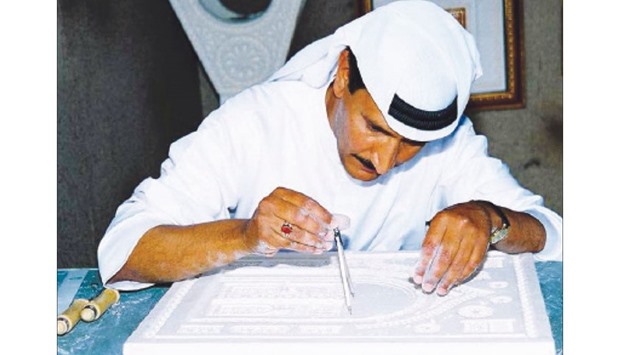In the past, traditional handicrafts were defined by the natural environments that surrounded human societies. This type of cultural expression is adapted to the climate and natural environment providing solutions to daily needs. Traditional handicrafts in the Gulf and the Arabian Peninsula have many similar cultural characteristics due to shared religion, language and history. The interactions within this region enabled frequent communication between people and paved the way for some influences from India, Persia and Africa.
However, in recent years and with oil discovery and globalisation, most of the Qatari trades and handicrafts industries have seen a significant decline. The new economic ventures offered through oil and gas is directly connected to the neglect of many crafts and folk industries like pearl diving which was the backbone of Qatar’s economy in the past. People turned to work in oil companies leaving traditional handicrafts businesses for a better paid job. Eventually, the concept of handicrafts and folk industries became insignificant to new generations who no longer wish to continue practising traditional handicrafts since there are better opportunities that allow them to maintain today’s Qatari lifestyle.
Some of the traditional Qatari handicrafts are:
Al Sadu: Sadu is a craft known to be used by Bedouin societies; it is a craft of knitting wool that comes from sheep, camels and goats. The tools used by women in the spinning and knitting process are called Meghzal, El Nul and Elmanshaza. This traditional handicraft is still alive and practised by some women in Qatar.
Al Khous : One of the traditional industries that has almost ceased to exist in Qatar, it was entirely dependent on palm leaves secured from different areas around the Gulf. Al Khous were used to make baskets, mats and other products that can be used in traditional Qatari households.
Gypsum decoration : This handicraft is well known in the Gulf region with its abstract nature, using architectural and natural themes. Gypsum was used because it can withstand extreme weather conditions. People in Qatar decorated the facades of their houses, palaces, forts, towers and mosques offering an aesthetic improvement.
Dhow-making : Dhow-making was in the past one of the main industries in Qatar. The industry depended on imported timber a specific kind from India like pine wood which can withstand the sea environment. The wood was coated with special oils called “Aldgs” to isolate the wood from sea water. The person who made these dhows was called Al Gallaf. Today, there is only one workshop that builds traditional dhows.
Some of the most important types of dhows are Al Bateel, Al Baghla, Al Galbot, Al Sanbok, elBoom, Al Baggara, elhori, Almachoh, and El Shahouf.
Pearl-diving: There are many historic accounts of the long standing practice of pearl-diving in the Gulf region that became a substantial source of income for the region.
There were two pearl-diving seasons: the great dive called “eloud” with a diving duration of about three or four months starting from June until the end of September. Then the second dive season called “Al Khanijeih” which lasted for about 40 days. However, with the discovery of oil and the invention of the Japanese cultured pearls, the demand for Gulf pearls declined.
In conclusion, practitioners of traditional handicrafts played a key role in Qatari community and sustained its economy before the discovery of oil. Protecting traditional handicrafts remains an important part of preserving our culture and identity for future generations. To that end it is important to adapt traditional practices to modern contexts and needs while maintaining the affiliated traditional values.
* Muhammad Saeed al -Bloshi graduated with a degree in Arts and Archaeology in 1984 from the faculty of Human and Social Sciences of the Lebanese University in Beirut. In 1991 he worked as a researcher in material culture, handicrafts and folkloric industries at the Folklore Center of the GCC and served as the director of the documentation department of the council in 1996. In 2000 he became a supervisor of the handicrafts and folkloric industries unit at the Ministry of Education and Culture.
He became a heritage expert for the Ministry of Culture, Arts and Heritage in 2006, and he was the Manager for the participation of the State of Qatar at the Shanghai Expo in 2010 and again at the Milan Expo in 2015. He is currently Heritage Consultant at the Ministry of Culture and Sports.
Intercultural Dialogue and Cultural Diversity Programme
The Intercultural Dialogue and Cultural Diversity Programme is the outcome of the co-operation established between Unesco Doha Office, Katara Cultural Village Foundation and Qatar National Commission for Unesco with the aim to promote cultural diversity and cross-cultural understanding and awareness.
The programme was launched on January 10, 2016 with the Cultural Diversity Festival that brought together performing groups from 21 countries representing different regions of the world and celebrating cultural pluralism in Qatar. It will come to a close with an expert conference on Promoting Dialogue and Diversity through Cultural Industries that is being held from December 6-8 in Doha. The venue of the conference is Building 15, Katara Cultural Village.
This mini article series shares selected contributions of Qatari and international experts from the conference with the wider public and aims to raise awareness around the social, cultural and economic impact of traditional handicraft practices. The views of the authors do not necessarily represent those of Unesco.

Gypsum was used to decorate the facades of buildings in Qatar.
